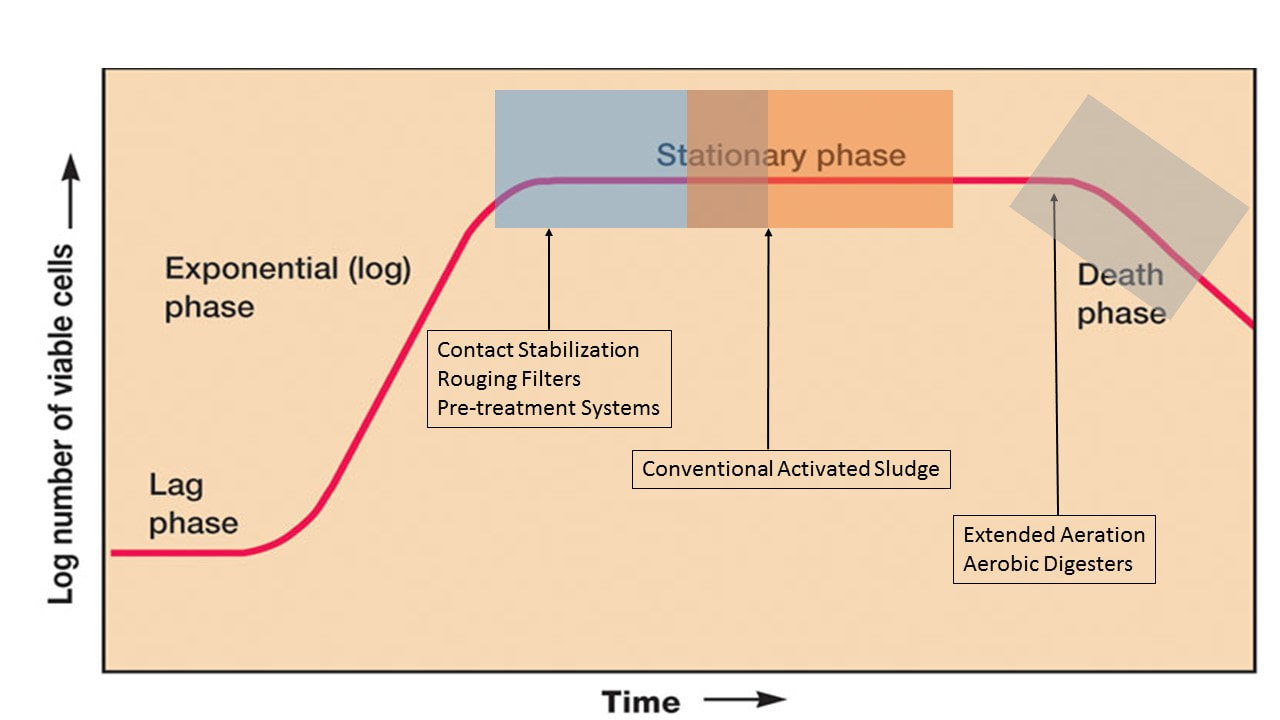Let's start with a refresher on the growth curve:
- Lag - bacteria and their enzymes needed to degrade the influent are not common in the biomass. It takes time for populations to adjust and enzyme pathways to activate. This is seen with massive changes in influent makeup or in totally new WWTP.
- Log - high F/M situation where bacteria grow rapidly. It is interesting to know that the bacteria thriving at this stage are often different from those seen further along the growth curve. OUR is high and effluent often is turbid.
- Stationary - F/M has dropped and cell division slows. Microbial populations shift to organisms capable of exploiting ecological niches such as nitrifiers, phosphate accumulators, and even filaments. This is the target zone for operating most activated sludge units.
- Endogenous (death) - often seen in aerobic digesters or in the sludge layer in polishing ponds, the Endogenous phase is where low soluble BOD results in a loss in viable bacterial cells and most importantly, lysis of dead cells. This phase releases bound water and reduces sludge volume for disposal.
You may have seen the term Steady-State being used in wastewater systems. It simply means that the microbial population is at the target growth curve point for good effluent quality. Steady-state conditions are not a singular point on the curve, but a range. Adjusting wasting, recycle rates, aeration, and even influent flow are tools to adjust your position on the growth curve.
When not in SS, the system exhibits signs of biological issues
- Foaming
- Bulking
- Odors
- Increased polymer demand
- Effluent quality issues
The New Challenge of Multiple Steady-States
Moving along the old growth curve was not as complex when effluent targets were BOD and TSS. We simply relied on natural population dynamics to reach a point where biomass removed soluble BOD and flocculated. Now with permits including BOD, Total Phosphate, and Total Inorganic Nitrogen (TIN) – we have systems with multiple steady-states as you need to have microbial populations balanced to achieve all the treatment goals. The key to efficient operations is to keep the system in the “ideal” range using all monitoring and control tools available.
Often the control tools are determined by your system's design and setup. All operational controls work by encouraging the growth of ideal microbial populations while limiting the undesirable organisms. None work instantly to correct problems. So, good monitoring helps you keep the system operating efficiently. Conventional monitoring with OUR, SV30, SVI, F/M, MCRT, and ATP is good for BOD removal information, but is not as effective at detecting changes in more niche organisms. For tracking ecological niche organisms, I suggest looking into molecular testing. With improved knowledge of niche organisms and lower costs for molecular testing, it can be a useful part of any monitoring program.
I have been a part of a team at Aster Bio has been using qPCR and metagenomic testing in wastewater treatment systems for over 7 years and have found that molecular tests are highly effective at monitoring slow growing niche organisms such as:
- PAO - phosphate accumulating organisms
- GAO - glycogen accumulating organisms
- AOB & NOB - ammonia oxidizing bacteria & nitrite oxidizing bacteria
- NRB - nitrate & nitrite reducing bacteria
- Filaments - (can even be customized to a specific system's most problematic filaments)
- Non-filamentous bulking
- Foaming (Nocardia forms)


 RSS Feed
RSS Feed